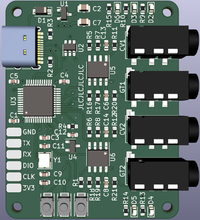Difference between revisions of "MIDItio"
Jump to navigation
Jump to search
(→MCU) |
|||
| Line 1: | Line 1: | ||
[[Category:Awesome Audio Apparatus]][[Category:STM32 Projects]][[Category:Work in progress]]{{metadesc|USB Midi to CV}} | [[Category:Awesome Audio Apparatus]][[Category:STM32 Projects]][[Category:Work in progress]]{{metadesc|USB Midi to CV}} | ||
| − | [[File:MIDItio rendering - top view.png|200px|thumb|MIDItio Rendering]] | + | [[File:MIDItio rev. a rendering - top view.png|200px|thumb|MIDItio Rendering]] |
[[MIDItio]] is a [[:Category:Work in progress|planned]] USB Midi to CV device. The device will act as a USB MIDI device connected to a USB host. It will be able to run two channels simultaneously with a CV indicating the pitch and a Gate indicating start and stop. | [[MIDItio]] is a [[:Category:Work in progress|planned]] USB Midi to CV device. The device will act as a USB MIDI device connected to a USB host. It will be able to run two channels simultaneously with a CV indicating the pitch and a Gate indicating start and stop. | ||
Revision as of 05:16, 19 August 2022
MIDItio is a planned USB Midi to CV device. The device will act as a USB MIDI device connected to a USB host. It will be able to run two channels simultaneously with a CV indicating the pitch and a Gate indicating start and stop.
The name MIDItio is derived from MIDI and the Latin "ditio" which means "control".
Hardware Design
MCU
The primary concerns dictating the choice of MCU are:
- Built-in USB
- Built-in Digital to Analogue converters (DAC) - preferably 2
- Cost
The STM32L151 fits the bill nicely.
Output Amplifier
Without a boost regulator the highest available voltage on the board is the USB VBUS 5V.

